Click On Image
For Full Size Image |
Size |
Image Description |
Contributed
By |
USS Barnett (AP-11)
|
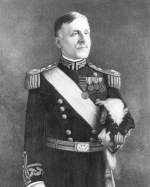 |
157k |
Namesake
George Barnett--born on 9 December 1859 at Lancaster, Wis.--entered the Naval Academy in June 1877 and graduated in 1881. Following two years of sea service as a naval
cadet, he was appointed a second lieutenant in the Marine Corps on 1 July 1883. After duty at various marine barracks on the east coast, as well as three years in Alaskan waters on board Pinta, he advanced to first lieutenant in September 1890 while serving in the steam sloop-of-war Iroquois. Lt. Barnett then served at the Marine Barracks at the Washington Navy Yard until June 1896 when he went on board the receiving ship Vermont in New York City. He reported to San Francisco in December 1897 for sea duty and then transferred to the protected cruiser New Orleans the following April, just in time for service in the Spanish-American War. Barnett's ship joined the Flying Squadron off Santiago de Cuba on 30 May, bombarded the harbor batteries on 6 and 16 June, and captured the French blockade runner Olinde Rodrigues on 17 July. Promoted to captain on 11 August 1898, he transferred to the protected cruiser Chicago in November of that year, serving in that ship during cruises to the Caribbean, the south Atlantic, and European waters. Capt. Barnett came ashore for duty at Marine Corps Headquarters in Washington, D.C., in May 1901. Promoted to major shortly thereafter, Barnett next took command of a battalion that embarked in the auxiliary cruiser Panther in September 1902. The warship sailed to the Caribbean that month, where Barnett's battalion landed to guard the railway transit of the Isthmus of Panama. In January 1903, he took command of another battalion guarding naval facilities in the Manila Bay area of the Philippines. While there, Barnett also served in several ships of the Asiatic Fleet. Returning to Washington in April 1905, Maj. Barnett advanced to lieutenant colonel and served as the commanding officer of the Washington Navy Yard Marine Barracks for the next year. When civil war threatened in Cuba in mid-1906, Barnett took command of an expeexpeditionary battalion, later growing to a regiment, in September. Transported to Havana on board the cruiser Minneapolis, Barnett's force soon moved to Cienfuegos,
where it deployed to occupy the towns of western and central Cuba. A large Army force relieved the marines in November, and Barnett returned to Washington in November
1906. After commanding the Marine Barracks for a year, Lt. Col. Barnett took over the 100-man Marine Corps detachment at the American Legation in Peking, China,
arriving there in early 1908. He returned to the United States during the summer of 1910 and assumed command of the Philadelphia Marine Barracks, in which billet he
received his promotion to colonel on 11 October. Over the next three years, Col. Barnett made repeated deployments to Cuba, in command of the 1st Marines, in order to
quell serious domestic disturbances on the island. The most serious of these expeditions took place in 1912, when Barnett took the 1st Marines to Guantanamo Bay on 28
May. Most of the marines returned to the United States by early August. Appointed to a four-year detail as Major General Commandant of the Marine Corps on 21 February
1914, Barnett led the Corps during a time of unprecedented activity and expansion. He worked hard to draw the Marine Corps into closer and more cordial relations with
the Navy, directed several important expeditions to countries in the Caribbean, and administered the Marine Corps through its great expansion during World War I. In
April 1914, when American forces landed at Veracruz, Mexico, Barnett sent a reinforced brigade of marines to that city. He also stationed an expeditionary force off the
west coast of Mexico later that year. When civil wars broke out in both Haiti and the Dominican Republic in 1915, Barnett placed a full brigade of marines in each of
these countries to maintain order and keep the peace. Barnett also guided the Marine Corps as it expanded to 3,000 officers and 75,500 enlisted men during World War
I--building training centers in Virginia and South Carolina, sending reinforcements to regular marine stations, and dispatching two Marine brigades to France. Made brigadier general on 29 August 1916, Barnett not only shepherded the Marine Corps through its wartime activities, but also through the difficult period of demobilization and reorganization at the close of the war in late 1918. For his outstanding service, he was awarded the Distinguished Service Medal by the Secretary of the Navy. Relieved as Commandant of the Marine Corps on 1 July 1920, he was given the rank of major general on 5 March 1921. Major General Barnett served the remaining years of active service as Commanding General of the Department of the Pacific. He retired on 9 December 1923 and died on 27 April 1930. Major General Barnett was buried at Arlington National Cemetery.
Photo: USMC History Division |
Bill Gonyo |
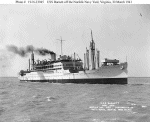 |
84k |
USS Barnett (AP-11) off Norfolk Navy Yard, Portsmouth, VA. 30 March 1941. Note the external degaussing cables installed on this ship's hull, and the davits for landing craft on her superstructure sides.
US National Archives photo # 19-N-23945, a US Navy Bureau of Ships photo now in the collections of the US National Archives. |
US Naval History and Heritage Command |
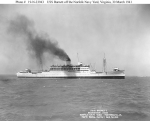 |
75k |
USS Barnett (AP-11) off Norfolk Navy Yard, Portsmouth, VA. 30 March 1941.
US National Archives photo # 19-N-23943, a US Navy Bureau of Ships photo now in the collections of the US National Archives. |
US Naval History and Heritage Command |
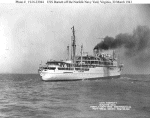 |
94k |
USS Barnett (AP-11) off Norfolk Navy Yard, Portsmouth, VA. 30 March 1941.
US National Archives photo # 19-N-23944, a US Navy photo Bureau of Ships photo now in the collections of the US National Archives. |
US Naval History and Heritage Command |
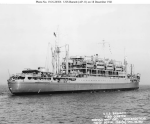 |
101k |
USS Barnett (AP-11) off Norfolk Navy Yard, 18 December 1941. The ship has received additional modifications, most notably
four new boat davits on each side, each serving two landing craft. Note her single 5"/51 gun and two 3"/50 guns aft, all with splinter protection.
US National Archives, RG-19-LCM, photo # 19-N-26506 a Bureau of Ships photo now in the collections of the US National Archives, courtesy Shipscribe.com. |
Mike Green |
 |
116k |
USS Barnett (AP-11), date and location unknown.
US Navy photo. Courtesy "The Floating Drydock" |
Frank Harmon |
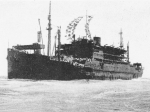 |
114k |
USS Barnett (AP-11) as seen from an assault barge during amphibious exercises on the Atlantic Coast in 1941.
Photos by Dmitri Kessel, Life Magazine. Used for educational and non-commercial purposes. |
Jim Kurrasch
Battleship Iowa Pacific Battleship Center |
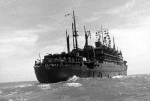
100300517 |
303k |
USS Barnett (AP-11) as seen from an assault barge during amphibious exercises on the Atlantic Coast in 1941.
Photos by Dmitri Kessel, Life Magazine. Used for educational and non-commercial purposes. |
John Chiquoine |
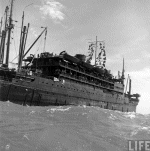
100300518 |
358k |
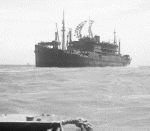
100300519 |
315k |
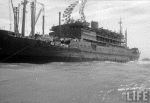
100300520 |
352k |
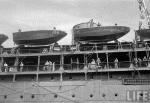
100300521 |
354k |
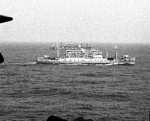
100300522 |
76k |
USS Barnett (AP-11) at a distance in a formation of troop transports as TF38 between 10 and 18 April, 1942. This was the earliest large force
departing the Tidewater and New York areas bound for Australia and Southwest Pacific. At extreme distance is
USS Hunter Liggett (AP27)
Photos by Frank Scherschel, Life Magazine, aboard USS Texas (B-35). Used for non-commercial and educational purpose. |
John Chiquoine |
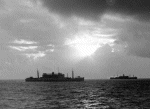
100300523 |
97k |
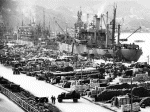
100201217 |
160k |
USS Barnett (AP-11) moored forward of USS Libra (AK-53) as the
ships work cargo at the Aotea Quay in the port of Wellington, N.Z, 12-13 in July 1942 while preparing for the upcoming Guadalcanal campaign, in September 1942.
Photo from the Museum Of Wellington. Used for non-commercial and educational purpose. |
John Chiquione |

100300524 |
372k |
USS Barnett (AP-11) in the floating drydock at Wellington, New Zealand, having her hull scraped, 4-7 October 1942.
Note - USS American Legion (AP-35) moored on the opposite side of the pier.
Photo from Museum Of Wellington, used for educational and non-commercial purpose. |
John Chiquoine |
USS Barnett (APA-5)
|
 |
77k |
Port side view of USS Barnett (APA-5) class camouflage Measure 32 Design 14T.
US Navy Bureau of Ships photo from "U.S. Amphibious Ships and Craft" by Norman Friedman. |
Robert Hurst |
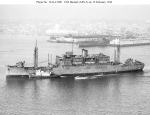 |
113k |
After conversion to an Attack Transport USS Barnett (APA-5) departed San Diego, 19 February 1943, enroute to Norfolk, VA. for
additional repairs. The four double boat davits fitted on each side in late 1941 have been replaced by three triple Welin davits on each side. The 5"/51 gun aft has been
removed and two 40-mm twin mounts have been fitted, one forward and one aft. The nearest ship in the background is probably
USS Alcyone (AKA-7).
US National Archives, RG-19-LCM, Photo # 19-N-84663, a US Navy Bureau of Ships photo now in the collections of the US National Archives. |
Mike Green |
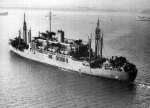 |
120k |
USS Barnett (APA-5) departing San Diego, 19 February 1943, enroute to Norfolk, VA. for additional repairs.
US Navy Bureau of Ships photo. |
Robert Hurst |
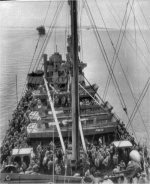 |
88k |
USS Barnett (APA-5) in convoy, her decks crowded with troops bound for Attu in the Aleutian Islands, 27 May 1943.
US Navy photo from AP Wirephoto. |
Tommy Trampp |
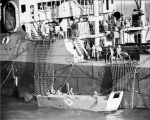
100300516 |
322k |
USS Barnett (APA-5), Operation Husky, the Allied Invasion of Sicily, Gela Landings, "Dime" beaches, 10-12 July 1943.
TimeLife_image_116108620, by J. R. Eyerman. Life Magazine. For personal non-commercial use only.
David Upton |
Tommy Trampp |
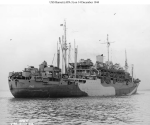 |
94k |
USS Barnett (APA-5) off the Norfolk Navy Yard, 14 December 1944. Note the configuration of the armament aft as modified in
early 1943, with a twin 40-mm mount on the centerline in place of the 5-inch gun and its director between the 3-inch guns. The triple Welin davits appear to be holding
their full complement of landing craft.
US National Archives, RG-19-LCM, Photo # Unknown a US Navy Bureau of Ships photo now in the collections of the US National Archives. |
Mike Green |
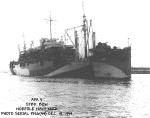 |
139k |
USS Barnett (APA-5) off Norfolk Navy Yard, Portsmouth, VA., 14 December 1944.
US Navy Bureau of Ships photo.
Courtesy "The Floating Drydock" |
Frank Harmon |
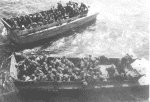 |
53k |
Two of USS Barnett (APA-5)'s LCVPs - loaded with troops for the invasion beaches.
US Navy photo |
Scott Dyben |
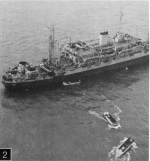 |
79k |
USS Barnett (APA-5) with LCVPs around her. During the Normandy landings Barnett carried troops of 4th Infantry
Division to Utah Beach.
US Navy photo. Photos and text scanned from "D-Day In Photographs by Portsmouth City Council", The History Press. ISBN 978 7524 7479 3. |
Robert Hurst |
























